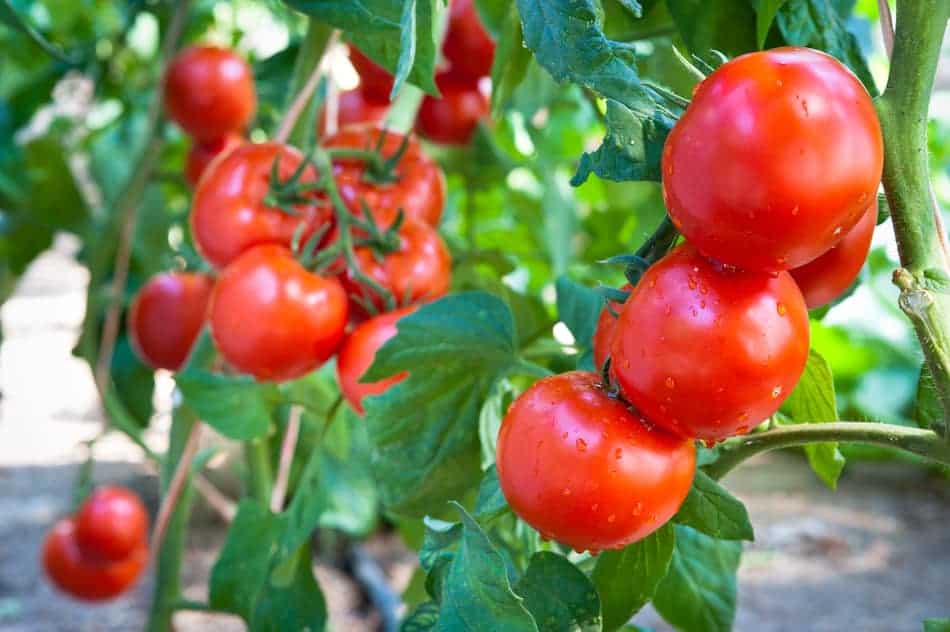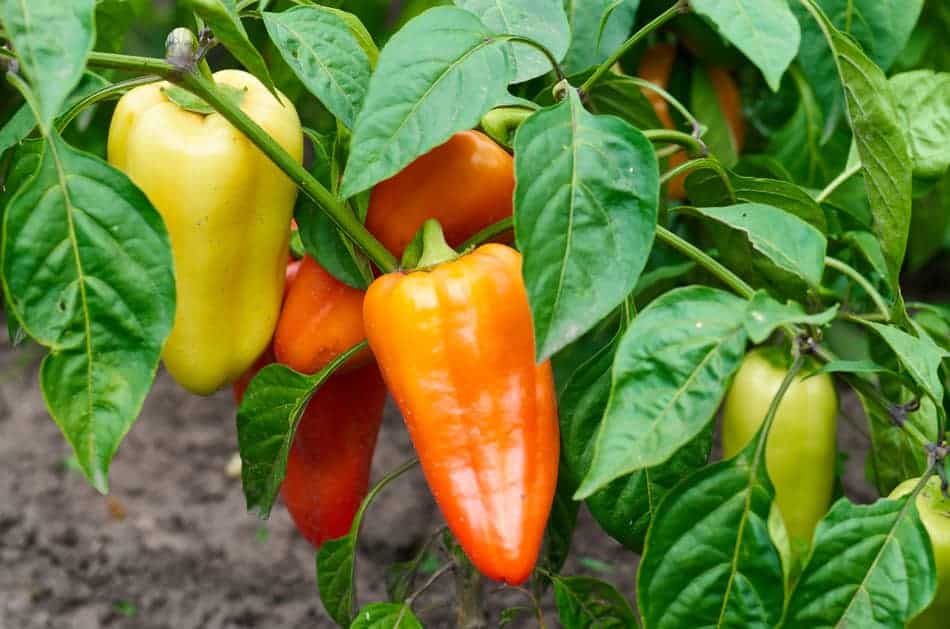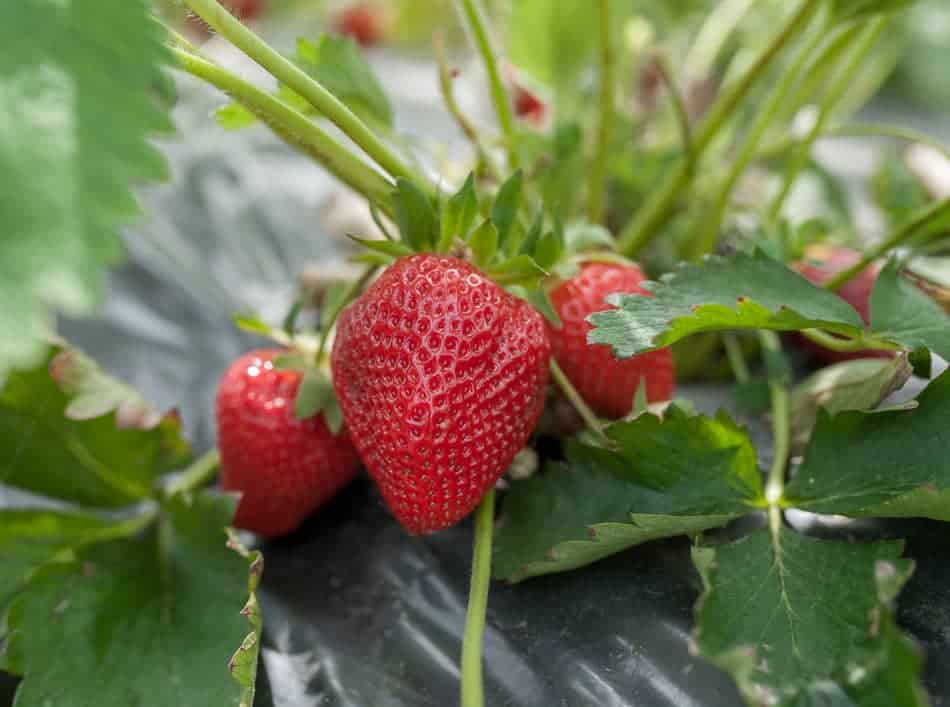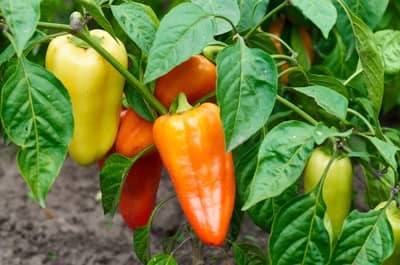With so many choices, it’s hard to decide what to grow. And for a greenhouse, you need to take into account your winter indoor temperature, as well as how hot it’ll get indoors in summer.
The best vegetables to grow in a greenhouse are ones you’ll eat or sell, & that thrive indoors: tomatoes, peppers, strawberries, lettuce & other greens, beans & peas, & cucumbers. Take advantage of cold-tolerant plants like greens during winter, and heat-tolerant plants like peppers during summer.
For more in-depth info on growing veggies year-round, check out my full answer/article on Can You Grow Vegetables Year Round in a Greenhouse?

Now, the best veggies to grow will depend on your zone, how much space you have to grow in, and how hot and cold it gets in your greenhouse.
Also, it’s always fun to grow a few interesting & weird plants besides the tried-and-true plants like tomatoes.
Wait–what?!
I decided to post this after seeing all the evidence that runs counter to common “wisdom.”
I was pretty surprised, so I want to share with you.
(And like everything I post, it’s evidence-based). Check it out:

Why Grow Vegetables In a Greenhouse?
So, why would you want to grow vegetables indoors?
Greenhouses & other indoor growing spaces are fantastic tools for growers.
Imagine growing vegetables all year round without worrying about the changing season, and not being concerned about the conditions outside.
Growing indoors opens up all kinds of possibilities!
So, by being in a greenhouse, plants also get to be protected from the harsh conditions they’d have to face outdoors: wind, drought, blistering heat, bone-chilling cold, pests, & critters trying to eat them.
And, a great thing about having an indoor growing space is that it allows you to create the most suitable conditions for your crops.
That’s because you can control factors like:
- Temperature
- Moisture
- Humidity
- Light
- Irrigation
- Fertilization
What Are the Best Vegetables to Grow Indoors?
It’s exciting to think about all the different kinds of veggies and fruits you could plant!
Sometimes though, it can be overwhelming to decide between all the different plants and varieties of each.
So where to start?
One way is to think about plants in categories. For example:
- Easy to grow
- High- producing
- Flowers
- Ornamentals
- Plants that are just plain weird and interesting
Here’s a quick list, summarized by category:
|
Category |
Best Plants |
|---|---|
|
Easy to grow |
|
|
High-producing |
|
|
Flowers |
|
|
Ornamentals |
|
|
Weird & interesting |
|
Do vegetables grow faster in a greenhouse?
A greenhouse is a closed environment, which means you can control the climate to suit specific vegetables. The carbon dioxide builds up inside and the plants use it to make food more efficiently. This gives vegetables prime growing conditions in a greenhouse and they can grow faster.
There are a lot of vegetables that are sensitive to their growing conditions, especially the temperature and amount of water they get.
In a greenhouse, you can control the temperature and humidity to suit the vegetables you plant.
This is because it’s a closed environment.
You can also make sure the plants get the correct amount of water.
In addition to all of this, in the closed greenhouse, carbon dioxide will gather and not escape easily.
Plants use carbon dioxide to produce food.
The high levels of carbon dioxide in a greenhouse can be used by the vegetable plants to produce food more efficiently than when they grow outdoors.
All of this means that the vegetables will grow faster in a greenhouse.
To understand about how to use a greenhouse effectively, read my post about Greenhouse Basics.
What vegetables should not be grown in a greenhouse?
If you control the environment appropriately in a greenhouse, you can grow any vegetable. It is possibly better to keep root vegetables to grow outside, as the cold temperatures of winter are an important part of their growth cycle.
Basically, any vegetables can be grown in a greenhouse.
However, you must avoid growing any that are sensitive to heat in your greenhouse, especially during summer.
This means avoiding planting cool weather vegetables, such as lettuce and cauliflower, in the warmer months.
Even though you can control the temperature and humidity in a greenhouse, the heat of summer will still make the overall temperatures higher than in winter.
When it comes to winter crops, there are divided opinions about growing root vegetables in a greenhouse.
This is because they are quite hardy and the lower temperatures they experience outside are part of their growth cycle.
You can grow them in a greenhouse during spring and fall, to extend their growing season.
Best vegetables to grow in a greenhouse in winter
The best vegetables to grow in a greenhouse in winter are cool season crops, such as radishes, kale, lettuce and broccoli. You can also plant more heat-tolerant cool season plants in fall and extend their growing season over the whole of winter, even into spring.
The most obvious vegetables to grow in a greenhouse in winter are cold-season plants, such as cool-season lettuce, potatoes and beets.
Radishes, turnips and kale are also good crops to grow in winter.
The list is not only limited to cool season crops, though.
Remember that one of the beauties of a greenhouse is that you can control the climate, as it is a closed environment.
If you do this successfully, cabbage, broccoli and Brussels sprouts will also do well in your greenhouse in winter.
Controlling the environment in a greenhouse also allows you to extend the growing season of some fall vegetables.
You can plant carrots earlier than late fall and they will grow through winter and well into spring.
Take note that a greenhouse environment can be a bit too warm at times, for plants that need the cold to be part of their growth cycle.
Anything is possible, though.
As long as you water the heat-sensitive vegetables regularly, they will grow successfully.
What a greenhouse can do is to extend the growing season of the cold-weather vegetables, so you can plant them in fall and then grow them throughout winter.
Cruciferous vegetables
In late winter, you can plant cruciferous plants that are quite hardy.
This means growing leafy vegetables that grow well in cooler temperatures.
These vegetables include winter lettuce, pak choi, spinach and kale, cabbage and broccoli, and Brussels sprouts.
Best vegetables to grow in a greenhouse in summer
The best vegetables to grow in a greenhouse in summer are those that can tolerate heat. These include tomatoes and cucumbers. You should also choose to grow vegetables that are tender growers, and some unusual types of vegetables.
In summer, you can grow a bigger variety of vegetables, because more vegetables are tolerant of heat than cold.
These are mainly warm-season vegetables, which will do well in the higher temperatures in a greenhouse.
Make sure you check up on what temperature is too hot for a greenhouse.
Heat loving vegetables
Tomatoes and cucumbers are very popular vegetables to grow in greenhouses throughout the year.
The controlled temperature in greenhouses means they can grow well in spring and fall too.
Both tomatoes and cucumbers are heat tolerant and can do well in a humid environment.
Both these vegetables thrive in greenhouses.
Sensitive vegetables
There are some tender vegetables that are quite sensitive to their growing conditions.
They especially don’t tolerate very low temperatures and frost.
They are well-suited to growing in greenhouses.
Bell peppers grow well in warmer conditions, but are very sensitive to heat.
They can be grown successfully in a greenhouse, especially in spring and fall.
Less common vegetables
There are some vegetables that are not commonly grown in your garden.
Mostly this is because they may need growing conditions that are not typical of your area.
A greenhouse is a great option for these vegetables.
Tomatillos are an unusual vegetable that grows naturally in warm to hot areas.
This makes them suitable for growing in a greenhouse, especially in colder areas.
Calabashes are vegetables grown on a vine that thrive in warm areas.
They can be grown successfully in a greenhouse.
You can find out more about what vegetables to choose in what season in my post about growing vegetables all year round in greenhouses.
Vegetables That Grow Well in a Controlled Environment
While thinking about which veggies would be great for your greenhouse, it would also be good to consider which ones would grow very well in a controlled environment.
With this in mind, you may either want to choose between cold season and warm season vegetables, or those that would love a specific setting such as heat.
For hot temperatures, plant types that would grow well and produce a good harvest are: varieties of peppers like jalapenos and sweet bells, chilies, tomatoes, as well as okra.
If you’re growing tomatoes like 95% of growers, you’ll want to read up on What Type of Soil is Best for Tomatoes?
Now, if you’re thinking about having warm season crops that need lots of sun, but require low to moderate temperatures during night time, the best ones for these would be: eggplant, cantaloupe, beans, cucumber, and summer squash.
Next, for crops that prefer cold temperature on the other hand, some good options are: cabbage, cauliflower, peas, turnips, leafy greens, chard, and beets.
|
Cool, warm, or hot? |
Best plants |
|---|---|
|
Veggies that love hot temperature |
|
|
Warm season crops |
|
|
Veggies that love cold temperature |
|
Crops That Aren’t Suited To a Greenhouse
Though most plants grow well in a controlled setting such as in a greenhouse, there are definitely some that are not best suited for one.
And, there are also crops that need wind pollination such as wheat, corn, oats, rice, barley and rye.
Or, those that need direct or full sunlight such as carrots, rutabaga and radish.
These can still be grown in a greenhouse; you’ll just need to make sure you give them the conditions they need to thrive.
|
category |
Best plants |
|---|---|
|
Cold frame needed |
|
|
Wind pollinated |
|
|
Needs full or direct sunlight |
|

Growing Veggies in a Greenhouse vs. Outdoors
Growing vegetables outdoors has a lot of differences from raising crops in a greenhouse.
The main difference is that indoors, you control all the variables: light, water, temperature, humidity, & soil nutrients.
Aside from having a controlled environment, where the temperature settings can be adjusted accordingly, humidity and moisture are also well regulated.
It gives the plant a constant supply of moisture both from the environment and the roots which reduces water stress.
If there is no water stress, plants can simply focus on flowering or fruiting.
Raising crops in a greenhouse, the soil is also specifically chosen which makes it very healthy for the plant.
Having the right soil, diseases and pests are also reduced as compared to when they are grown outdoors.
If there would be a downside to having one, it may just simply be the running costs that come with it, but unless you are ready to commit to a long term investment, then there should not be any worries.
However, planting crops outdoors on the other hand has its own pros and cons too.
One disadvantage is that plants are forced to rely on soil moisture alone which then leads to water stress, and this usually happens in drought situations.
And, since the sun is still the best source of light, outdoor crops can definitely grow bigger and healthier.
Another good thing about this is that it does not really have to cost you much, and if at all, may even cost you nothing except for time and effort.
|
Greenhouse |
Outdoors |
|---|---|
|
|
Other Plants to Grow Indoors
One cool thing about owning a greenhouse is that you can plant anything that you want.
You’re not just limited to planting vegetables and other food crops.
You can grow other plants that may give you some extra income and are easy to plant, like mushrooms.
Or plants with medicinal properties, like ginseng.
Apart from these, you could also grow flowers indoors–especially those that are require specific conditions. For example, orchids or roses.
Or, you could choose flowers for other reasons–flowers that are unusual or especially fragrant.
One example is the Amazon lily, which can grow to only up to 2 feet tall, and smells really nice.
Another option is African violets, which come in a variety of colors, and give a colorful ambiance.
Ornamentals are quite popular to grow in a greenhouse too, and they can be classified based on their needs like:
- Humidity
- Sun
- Shade
- Other features
Some best ornamentals are: impatiens, ferns, poinsettias, geraniums, petunias and more.
Next: Non-tree fruits are fun to grow, like melons, grapes, raspberries, and strawberries.
However: Keep in mind that grapes require some care, and that not all varieties do well in indoor environments.
Likewise for indoor fruit crops: strawberries are also highly popular because once they’re planted, they can produce fruit for longer than if they’re grown outdoors.
And after harvest, its space can be delegated for another crop.
In addition, other more interesting plants that can be grown in a greenhouse are: cacti, some types of tropical plants, or even a Venus flytrap!
|
category |
Best plants |
|---|---|
|
Easy to plant + extra income |
|
|
Flowers that need constant temperature |
|
|
Pretty or fragrant flowers |
|
|
Ornamentals |
|
|
Non-tree fruits |
|
|
Weird or interesting plants |
|
Making A Profit
Even though maintaining a greenhouse can be expensive, there’s an upside: you might be able to turn a profit on it.
Now, depending on the kinds of plants you choose, some can be pretty profitable.
Not everyone cares about turning a profit, but it’s an option to consider.
Now, you probably won’t be swimming in benjamins, but some growers like to turn their extra harvest into cash–your local farmer’s markets and local high-end restaurants are great places to start.
For example, a greenhouse that has, say, about 700 crops can potentially generate around $15,000 to $20,000 a year, so then the more productive & high-price-point crops you have, the better your chances of generating a profit.
Some of the most highly profitable crops that are not easy to grow are: peppers, strawberries, herbs, tomatoes, cucumbers, and lettuce.
Plus, don’t forget non-veggies, like cut flowers–some varieties can be quick to grow, and have high demand for farmer’s markets or wedding bouquets.

Related Questions
What vegetables can you grow year round in a greenhouse?
Crops also have their own specific time to grow so it is best to check the season to know which ones are good, but the most common ones that are grown year round are: tomatoes, cucumbers, strawberries, lettuce, squash, eggplant, broccoli cabbage, spinach, peppers, turnips, kale, snow peas and melons.
What can I grow in an unheated greenhouse over winter?
For an unheated greenhouse in winter, the best plants are cool-tolerant: garlic & onions, lettuce, spinach, microgreens & other greens, peas, and asparagus.
However, it’ll depend whether you want perennials like asparagus, or plants you can harvest quickly like greens.
Greenhouse Planting Guide
In order to identify your planting schedule, find out the nature of the vegetables that you would be growing. Whether they are for cool or warm weather. S
ome seeds take only a short time to germinate like for only 2 weeks, but others take as long as 12 weeks.
What can I grow in a small greenhouse?
Even with a tiny space, but with just the proper positioning or shelving, a grower can still raise a variety of crops that includes: lettuce, herbs, greens, tomatoes, French beans, peppers and chilies, strawberries, melons, cucumber and squash.


